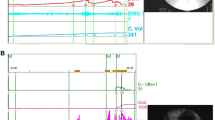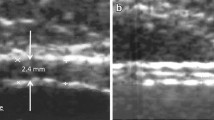Abstract
Introduction and hypothesis
Aims of this study were to compare the ultrasound measurement of bladder wall thickness (BWT) in women with different urodynamic diagnosis and to correlate BWT to the different urodynamic findings of detrusor overactivity (DO).
Methods
Two hundred forty seven women with urinary symptoms have been prospectively enrolled. Urodynamics and transvaginal ultrasound BWT were performed. Patients were divided into four urodynamic subgroups. BWT of women with DO was compared with the BWT of any other subgroup.
Results
Women with DO had a BWT value significantly higher (p < 0.0001). A cut-off of 6.5 mm for BWT had a positive predictive value of 100% for all DO. We use ROC curves to analyze the BWT for urgency urinary incontinence (AUC 0.645 95% CI 0.57–0.72) and the BWT for “pure DO” (AUC 0.702 95% CI 0.64–0.76) and for “all DO” (AUC 0.704 95% CI 0.64–0.77) vs other urodynamic diagnoses.
Conclusions
The ultrasound BWT showed a highly significant association with DO. However, the performance of this test cannot currently replace urodynamic testing.


Similar content being viewed by others
References
Abrams P, Andersson KE, Birder L, Brubaker L, Cardozo L, Chapple C et al (2009) Recommendations of the international scientific committee: Evaluation and treatment of urinary incontinence, pelvic organ prolapse and faecal incontinence. In: Abrams P, Cardozo L, Khoury S, Wein A (eds) Incontinence, 4rd international consultation on incontinence. Health, Paris, pp 1784–1787
Nwosu CR, Khan KS, Chien PF, Honets MR (1998) Is real-time ultrasonic bladder volume estimation reliable and valid? A systematic overview. Scand J Urol Nephrol 32:325–330
Gehrich A, Stany MP, Fischer JR, Buller J, Zahn CM (2007) Establishing a mean postvoid residual volume in asymptomatic perimenopausal and postmenopausal women. Obstet Gynecol 110:827–832
Choe JH, Lee JY, Lee KS (2007) Accuracy and precision of a new portable ultrasound scanner, the BME-150A, in residual urine volume measurement: a comparison with the bladderscan BVI 3000. Int Urogynecol J Pelvic Floor Dysfunct 18:641–644
Haylen BT, Frazer MI, MacDonald JH (1989) Assessing the effectiveness of different urinary catheters in emptying the bladder: an application of transvaginal ultrasound. Br J Urol 64:353–356
Tunn R, Schaer G, Peschers U, Bader W, Gauruder A, Hanzal E et al (2005) Updated recommendations on ultrasonography in urogynecology. Int Urogynecol J Pelvic Floor Dysfunct 16:236–241
Dietz HP (2004) Ultrasound imaging of the pelvic floor. Part I: two dimensional aspects. Ultrasound Obstet Gynecol 23:80–92
Dietz HP, Wilson PD, Clarke B (2001) The use of perineal ultrasound to quantify levator activity and teach pelvic floor muscle exercises. Int Urogynecol J Pelvic Floor Dysfunct 12:166–168
Braekken IH, Majida M, Ellstrom-Engh M, Dietz HP, Umek W, Bø K (2008) Test-retest and intra-observer repeatability of two-, three- and four-dimensional perineal ultrasound of pelvic floor muscle anatomy and function. Int Urogynecol J Pelvic Floor Dysfunct 19:227–235
Dietz HP, Wilson PD (1999) The influence of bladder volume on the position and mobility of the urethrovesical junction. Int Urogynecol J Pelvic Floor Dysfunct 10:3–6
Khullar V, Salvatore S, Cardozo L, Bourne TH, Abbott D, Kelleher C (1994) A novel technique for measuring bladder wall thickness in women using transvaginal ultrasound. Ultrasound Obstet Gynecol 4:220–223
Khullar V, Cardozo L, Salvatore S, Hill S (1996) Ultrasound: a noninvasive screening test for detrusor instability. BJOG 103:904–908
Robinson D, Anders K, Cardozo L, Bidmead J, Toozs-Hobson P, Khullar V (2002) Can ultrasound replace ambulatory urodynamics when investigating women with irritative urinary symptoms? BJOG 109:145–148
Minardi D, Piloni V, Amadi A, El Asmar Z, Milanese G, Muzzonigro G (2007) Correlation between urodynamics and perineal ultrasound in female patients with urinary incontinence. Neurourol Urodyn 26:176–182
Blatt AH, Titus J, Chan L (2008) Ultrasound measurement of bladder wall thickness in the assessment of voiding dysfunction. J Urol 179:2275–2278
Lekskulchai O, Dietz HP (2008) Detrusor wall thickness as a test for detrusor overactivity in women. Ultrasound Obstet Gynecol 32:535–539
Salvatore S, Serati M, Digesu GA, Triacca P, Uccella S, Khullar V et al (2008) Efficacy of tolterodine in relation to different urodynamic findings of detrusor overactivity. Int Urogynecol J Pelvic Floor Dysfunct 19:701–704
Serati M, Salvatore S, Uccella S, Cromi A, Khullar V, Cardozo L et al (2008) Urinary incontinence at orgasm: relation to detrusor overactivity and treatment efficacy. Eur Urol 54:911–915
Bump RC, Mattiasson A, Bo K, Brubaker LP, DeLancey JO, Klarskov P et al (1996) The standardization of terminology of female pelvic organ prolapse and pelvic floor disfunction. Am J Obstet Gynecol 175:10–17
Schafer W, Abrams P, Liao L, Mattiasson A, Pesce F, Spangberg A et al (2002) Good urodynamic practices: uroflowmetry, filling cystometry, and pressure-flow studies. Neurourol Urodyn 21:261–274
Haylen BT, de Ridder D, Freeman RM, Swift SE, Berghmans B, Lee J et al (2009) An international urogynecological association (IUGA)/international continence society (ICS) joint report on the terminology for female pelvic floor dysfunction. Int Urogynecol J Pelvic Floor Dysfunct. doi:10.1007/s00192-009-0976-9
Haylen BT (1989) Residual urine volumes in a normal female population: application of transvaginal ultrasound. Br J Urol 64:347–349
Kuo HC (2009) Measurement of detrusor wall thickness in women with overactive bladder by transvaginal and transabdominal sonography. Int Urogynecol J Pelvic Floor Dysfunct 20:1293–1299
Muller L, Bergstrom T, Hellstrom M, Svensson E, Jacobsson B (2000) Standardized ultrasound method for assessing detrusor muscle thickness in children. J Urol 164:134–138
Chung SD, Chiu B, Kuo HC, Chuang YC, Wang CC, Guan et al (2009) Transabdominal ultrasonography of detrusor wall thickness in women with overactive bladder. BJU Int 105:668–672
Panayi DC, Khullar V, Fernando R, Tekkis P (2010) Transvaginal ultrasound measurement of bladder wall thickness: a more reliable approach than transperineal and transabdominal approaches. BJU Int. doi:10.1111/j.1464-410x.2010.09367.x
Latthe PM, Champaneria R, Khan KS (2010) Systematic review of the accuracy of ultrasound as the method of measuring bladder wall thickness in the diagnosis of detrusor overactivity. Int Urogynecol J Pelvic Floor Dysfunct. doi:10.1007/s00192-010-1144-y
Oelke M (2010) International consultation on incontinence-research society (ICI-RS) report on non-invasive urodynamics: the need of standardization of ultrasound bladder and detrusor wall thickness measurements to quantify bladder wall hypertrophy. Neurourol Urodyn 29:634–639
Conflicts of interest
None.
Author information
Authors and Affiliations
Corresponding author
Additional information
Trial Registration: ClinicalTrials.gov ID NCT01003457
Rights and permissions
About this article
Cite this article
Serati, M., Salvatore, S., Cattoni, E. et al. Ultrasound measurement of bladder wall thickness in different forms of detrusor overactivity. Int Urogynecol J 21, 1405–1411 (2010). https://doi.org/10.1007/s00192-010-1194-1
Received:
Accepted:
Published:
Issue Date:
DOI: https://doi.org/10.1007/s00192-010-1194-1




